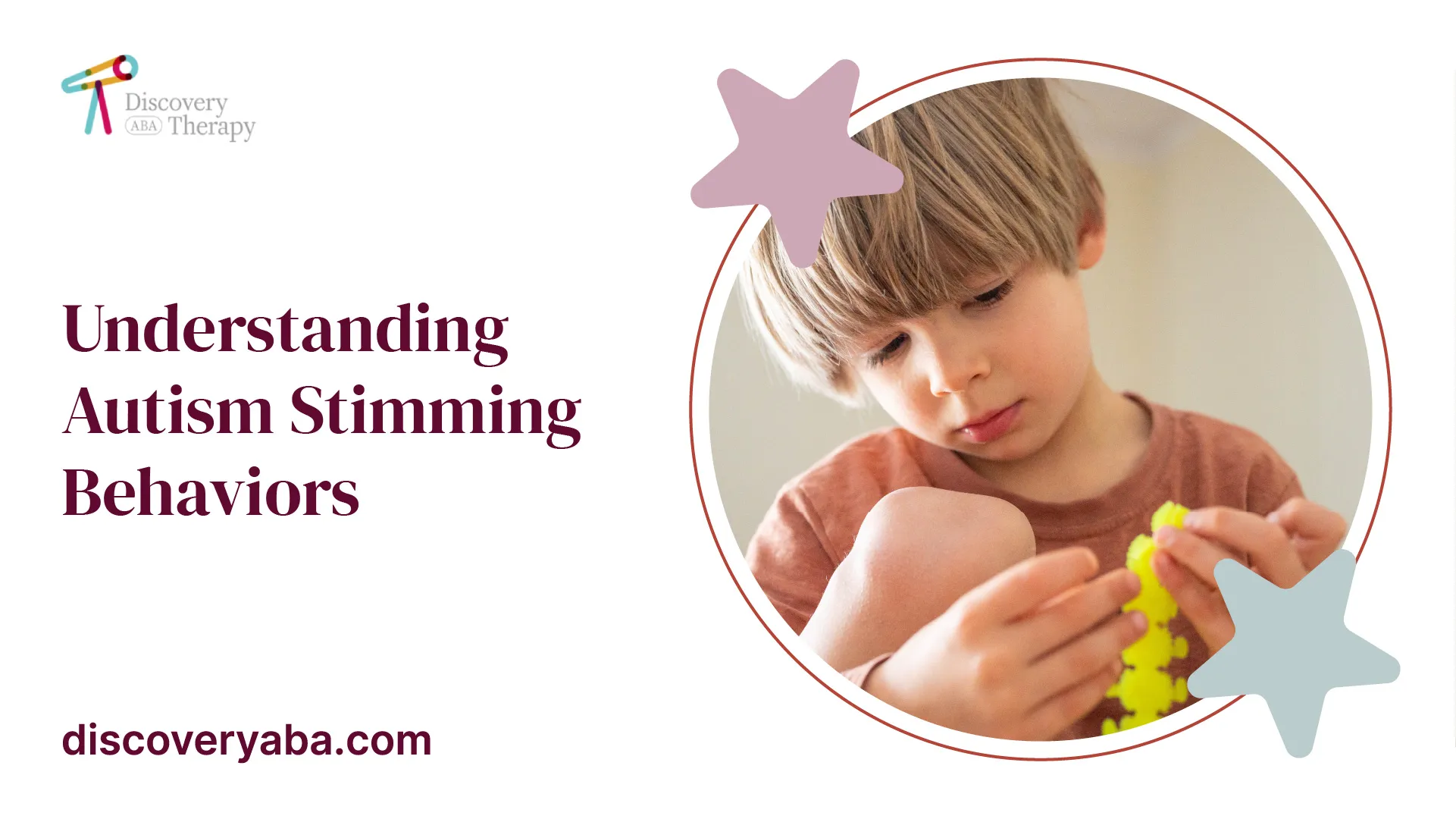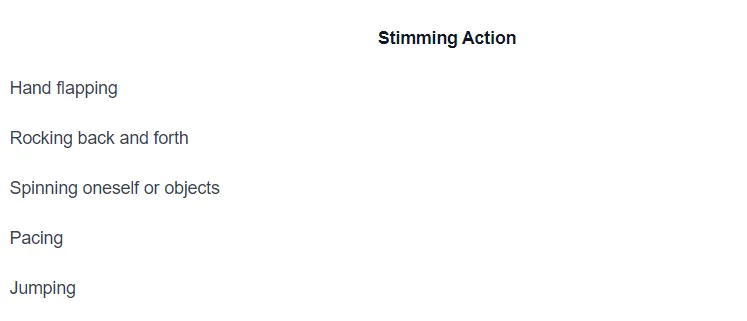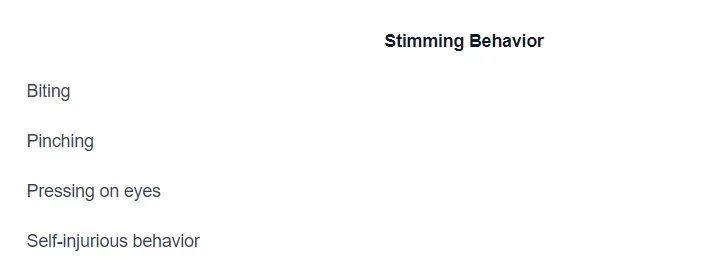Understanding Autism Stimming Behaviors
Understanding autism stimming behaviors - uncover the mysteries and find ways to support individuals with autism.

Understanding Stimming in Autism
Stimming, short for self-stimulatory behaviors, is commonly observed in individuals diagnosed with autism spectrum disorder (ASD). Stimming behaviors involve repetitive movements or sounds that go beyond what is considered culturally or socially acceptable. Understanding stimming and its significance in autism is crucial for promoting awareness and acceptance.
Definition and Importance of Stimming
Stimming is part of the diagnostic criteria for autism, as it refers to self-stimulating behaviors usually involving repetitive movements or sounds. It is important to note that not all forms of stimming are related to autism. Stimming behaviors can serve various purposes for autistic individuals, including emotional self-regulation and sensory processing.

For many autistic individuals, stimming is a tool for emotional self-regulation. Autistic people often face sensory processing challenges, which can lead to over-responsiveness or under-responsiveness to stimuli such as sounds, light, textures, and smells. Stimming provides a way to manage and cope with these sensory experiences, helping individuals regulate their emotions and find relief.
Differences in Stimming Behavior
Stimming behaviors can vary in frequency and intensity from person to person. Autistic individuals may engage in stimming that is more obvious and lasts for longer periods compared to non-autistic individuals. Examples of autistic stimming behaviors include hand-flapping, spinning in circles, and repetitive vocalizations. These behaviors may be more pronounced and distinct in autistic individuals.
It is important to recognize that stimming can serve different functions and may vary depending on the individual. While some stimming behaviors are considered harmless and provide necessary support for emotional regulation and sensory processing, others may need to be managed. Stimming behaviors that persist for extended periods or pose physical harm, such as self-injurious actions like head-banging or hand-biting, require attention and intervention.
Understanding the definition and importance of stimming in autism, as well as the differences in stimming behaviors, contributes to a more inclusive and accepting society. By promoting understanding and support, we can create an environment that embraces the unique experiences and needs of individuals on the autism spectrum.
Types of Stimming Behaviors
Stimming behaviors, short for self-stimulatory behaviors, are common in individuals with autism and serve various purposes such as self-regulation and sensory processing. It's important to understand the different types of stimming behaviors to gain insight into the experiences of autistic individuals. Stimming behaviors can be categorized into two main types: common stimming actions and harmful stimming behaviors.
Common Stimming Actions
Common stimming actions are behaviors frequently observed in individuals with autism. These actions are often repetitive and can provide comfort, relieve anxiety, or help individuals regulate their emotions. While these behaviors may be less socially accepted compared to ordinary behaviors like nail-biting or hair-twirling, they are generally harmless and serve as coping mechanisms.
Common stimming actions include:

These repetitive movements or actions can help individuals with autism process sensory information, reduce stress, or express excitement. It's important to note that these behaviors are typically not harmful to the individual or others around them. Understanding and accepting these common stimming actions can foster a more inclusive and supportive environment for individuals with autism.
Harmful Stimming Behaviors
While most stimming behaviors in individuals with autism are not harmful, there are cases where certain stimming behaviors may require management to prevent physical harm. These harmful stimming behaviors may persist for extended periods of time or become a daily occurrence, causing distress and impaired emotional self-regulation.
Harmful stimming behaviors include:

It's important to address and manage harmful stimming behaviors to ensure the safety and well-being of individuals with autism. These behaviors may require intervention from professionals to understand the underlying causes and develop strategies to redirect or replace them with safer alternatives. The goal is to provide support and guidance to individuals with autism, helping them find healthier ways to self-regulate and manage their emotions.
Understanding the differences between common stimming actions and harmful stimming behaviors is essential in creating a supportive and inclusive environment for individuals with autism. By acknowledging the importance of stimming as a coping mechanism and providing appropriate strategies for management, we can help individuals with autism lead fulfilling lives while respecting their unique needs and experiences.
Reasons Behind Stimming
Stimming behaviors are a common characteristic of autism, and understanding the reasons behind stimming is crucial for providing support and promoting understanding. Two key reasons for stimming in autism are emotional regulation and sensory processing challenges.
Emotional Regulation
For many autistic individuals, stimming serves as a tool for emotional self-regulation. Stimming behaviors can help manage and express emotions, providing a sense of comfort and relief. Autistic individuals often face sensory processing challenges, leading to over-responsiveness or under-responsiveness to stimuli such as sounds, light, textures, and smells [2]. By engaging in stimming, they can regulate their emotions and reduce feelings of anxiety or overwhelm.
Stimming behaviors can also serve as a way to communicate emotions. Autistic individuals may use specific stimming actions to convey their feelings to others, allowing them to express joy, excitement, or frustration when verbal communication may be challenging.
Sensory Processing Challenges
Sensory processing challenges play a significant role in stimming behaviors among autistic individuals. Many individuals with autism experience sensory sensitivities, where they may be hypersensitive or hyposensitive to certain stimuli. Stimming can help them cope with these sensory challenges and adapt to their environments.
Stimming behaviors provide a way to counteract sensory overload and regulate sensory input. Engaging in repetitive movements or actions can help autistic individuals focus their attention and block out overwhelming stimuli. By creating a predictable and rhythmic pattern, stimming can provide a calming effect and restore a sense of control.
Understanding the sensory preferences and sensitivities of autistic individuals is essential in managing stimming behaviors. Creating sensory-friendly environments and providing opportunities for sensory input can help minimize sensory overload and reduce the need for stimming as a coping mechanism. Working with behavior specialists or autism professionals can provide valuable insights and strategies for effectively managing stimming behaviors and promoting overall well-being.
By recognizing the reasons behind stimming, it becomes clear that stimming behaviors serve important purposes for autistic individuals. It is crucial to approach stimming behaviors with empathy, understanding, and acceptance, as they play a significant role in the lives of individuals on the autism spectrum.
Impact of Stimming
Stimming behaviors in individuals with autism can have both social and personal implications. Understanding the impact of stimming is crucial for promoting social awareness, acceptance, and managing these behaviors effectively.
Social Awareness and Acceptance
Stimming behaviors can vary in frequency and intensity from person to person. For some autistic individuals, stimming can become an everyday occurrence that is difficult to stop and can last for hours. It's important for society to be aware of and accepting of stimming behaviors, recognizing that they are a natural part of an individual's self-expression and coping mechanisms.
While people who are not autistic (neurotypical) may cease stimming when they receive social cues indicating that their behavior is attracting attention, autistic individuals may have difficulty picking up on these cues and continue stimming even in socially inappropriate situations. Promoting social awareness and acceptance helps create an inclusive environment where individuals with autism feel understood and supported.
Managing Stimming Behaviors
While stimming can serve as a valuable tool for emotional self-regulation in autistic individuals, it is important to manage stimming behaviors when they persist for extended periods or pose physical harm. Some stimming behaviors, such as self-injurious actions like head-banging or hand-biting, may require intervention and support.
Managing stimming behaviors involves finding a balance between allowing individuals to engage in self-soothing and identifying when certain stimming behaviors may be harmful or interfere with daily functioning. Strategies such as redirecting stimming behaviors to more socially acceptable alternatives, providing sensory input opportunities, and creating a supportive environment can help in managing stimming behaviors effectively.
It's important to note that some stimming behaviors may worsen if autistic individuals feel ostracized or alone. Therefore, creating a supportive environment that fosters understanding, acceptance, and inclusion is vital for managing stimming behaviors and promoting the overall well-being of individuals with autism.
Understanding the impact of stimming and promoting social awareness and acceptance can play a significant role in creating a more inclusive society. By providing individuals with autism the support they need and employing strategies for managing stimming behaviors, we can help them navigate their daily lives more comfortably while embracing their unique ways of self-expression and emotional regulation.
Strategies for Managing Stimming
When it comes to managing stimming behaviors in individuals with autism, there are various strategies that can be implemented to create a supportive and inclusive environment. Two effective approaches for managing stimming behaviors include environmental modifications and providing sensory input opportunities.
Environmental Modifications
Making appropriate modifications to the environment can help individuals with autism manage their stimming behaviors more effectively. Here are some strategies that can be implemented:
- Creating a Calming Environment: Designating a calm and quiet space where individuals can retreat when they feel overwhelmed can be beneficial. This area should be free from excessive sensory stimuli, such as bright lights or loud noises. Providing comfortable seating, dim lighting, and soothing sensory elements, like soft textures or calming scents, can contribute to a more relaxing environment.
- Establishing Predictability and Routine: Individuals with autism often thrive in structured and predictable environments. Creating a consistent daily schedule and offering clear visual cues, such as visual schedules or timers, can help reduce anxiety and provide a sense of stability. When individuals know what to expect, it can help alleviate the need for excessive stimming behaviors.
- Minimizing Sensory Overload: Sensory overload can trigger stimming behaviors in individuals with autism. Adjusting the environment to minimize sensory stimuli can be beneficial. This may involve reducing background noise, using noise-canceling headphones, providing sunglasses or visors to manage bright lights, or using sensory tools like fidget toys to offer alternative forms of stimulation.
Sensory Input Opportunities
Another approach to managing stimming behaviors is to provide appropriate sensory input opportunities. By offering alternative sensory experiences, individuals with autism can redirect their stimming behaviors in a more socially acceptable manner. Here are some strategies that can be employed:
- Sensory Diet: A sensory diet involves incorporating specific sensory activities into an individual's routine to meet their sensory needs. This may include activities such as deep pressure activities, swinging, bouncing on a therapy ball, or engaging in sensory play. By providing regulated and controlled sensory input, individuals can satisfy their sensory cravings in a more constructive manner.
- Fidget Tools and Chewable Items: Fidget tools and chewable items can help redirect stimming behaviors in a positive way. These tools provide individuals with a socially acceptable outlet to satisfy their sensory needs. Fidget spinners, stress balls, chewable necklaces, or textured objects are examples of items that can be used.
- Physical Activities: Engaging in physical activities can provide individuals with an opportunity to release excess energy and regulate their sensory system. Activities such as jogging, dancing, yoga, or swimming can be effective in channeling stimming behaviors into constructive movements.
It's important to note that each individual with autism is unique, and the effectiveness of these strategies may vary. It is recommended to work closely with professionals, such as behavior specialists or medical professionals, to tailor strategies to meet the specific needs of each individual.
By implementing environmental modifications and providing sensory input opportunities, individuals with autism can effectively manage their stimming behaviors in a way that promotes their well-being and supports their overall development.
Seeking Professional Guidance
When it comes to understanding and managing stimming behaviors in individuals with autism, seeking professional guidance can be instrumental in providing effective strategies and support. Behavior specialists and medical professionals can offer valuable insights and assistance in navigating this aspect of autism.
Working with Behavior Specialists
Behavior specialists, such as autism specialists or behavior analysts, are professionals with expertise in understanding and addressing the unique challenges faced by individuals with autism. They can provide guidance and develop personalized strategies to manage stimming behaviors effectively.
Behavior specialists work closely with individuals and their families to assess the specific stimming behaviors and their underlying causes. Through observation and analysis, they identify triggers and patterns associated with stimming. Based on this assessment, they develop individualized behavior plans that focus on understanding the reasons behind stimming and addressing the underlying needs.
The recommendations from behavior specialists may include techniques to encourage self-control, alternative coping mechanisms, and improving communication around stimming behaviors. They also assist in setting realistic expectations and goals for managing stimming, promoting a supportive and understanding environment for individuals with autism.
Medical Professional Consultation
Seeking advice from a medical professional is crucial before taking any actions to manage stimming behaviors in individuals with autism. It is essential to determine whether the behavior is stimming-related or if there are underlying health concerns that need to be addressed.
Medical professionals, such as pediatricians, developmental pediatricians, or psychiatrists, can provide insights and guidance on managing stimming effectively. They have the expertise to assess the overall health and well-being of individuals with autism and can play a vital role in understanding the relationship between stimming behaviors and any underlying medical conditions.
Medical professionals can collaborate with behavior specialists to develop a comprehensive approach to managing stimming behaviors. They may recommend additional evaluations or interventions, if necessary, to ensure that the individual's overall health needs are addressed alongside stimming management.
In conclusion, seeking professional guidance is crucial in understanding and managing stimming behaviors in individuals with autism. Behavior specialists and medical professionals can provide valuable insights, personalized strategies, and support to individuals and their families. By working collaboratively with these professionals, it becomes possible to develop effective approaches that promote a better understanding of stimming behaviors and enhance the overall well-being of individuals with autism.
References
Does Your Child Have An Autism Diagnosis?
Learn More About How ABA Therapy Can Help
Find More Articles
Contact us
North Carolina, Nevada, Utah, Virginia
New Hampshire, Maine
Arizona, Colorado, Georgia, New Mexico, Oklahoma, Texas
.avif)




































































































